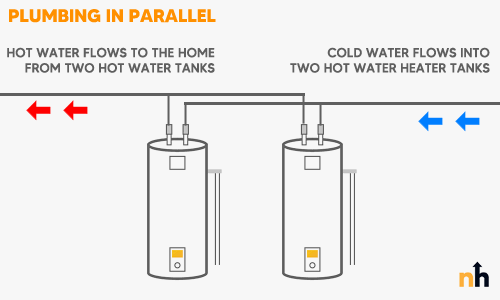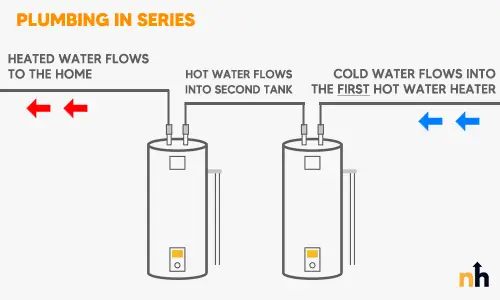Most plumbers recommend water heaters to be connected in parallel because it delivers higher water output, prolongs the life of each water heater, and eliminates undue stress on a single water heater.
It has been an age-old question for many homeowners building a new home. When a home has increased demand for water during a short period of time, most plumbers suggest adding a second water heater. Can you add a second hot water tank? Yes, a home can have more than one, two, or three hot water heaters – as this will depend entirely on demand.
A large household with multiple people taking showers, or a home that has an indoor spa tub would require an additional water heater to meet the demand for water. It’s important to note that there are two ways of connecting multiple water heaters in a new build home. Let’s have a look at both connection types.
Table of Contents
Parallel Water Heater Installation
In a parallel water heater installation, cold water enters into multiple tanks to get heated, and then leaves those tanks at the same rate as hot water.
This type of installation usually includes hot water tanks that have the same storage capacity, as well as British thermal units. In this installation, the hot water will leave the tanks at the same rate. If five gallons of hot water leave each tank, five gallons of cold water will enter each tank to be heated.

Plumbing in Parallel for Hot Water Heaters
With two or more tanks providing heating, each tank will work equally as hard to heat the water. There is no one tank that will do more work than the other, prolonging the life of all tanks in this installation.
A plumber will also know that the pipes supplying and delivering the cold water need to be the exact same length. Similarly, the pipes delivering the hot water to the home from both tanks need to be the same length as well.
The reason for the pipe lengths is because the cold water is supplied to the home at a set pressure. If the distance from the cold water inlet to one of the water heaters is shorter, then this water tank would be doing most of the work. To prevent this uneven balance in pressure, the pipe lengths are kept the same for both water heaters.
Series Water Heater Installation
In a series water heater installation, cold water will enter the first tank and get heated and will travel to the second water heater tank. When demand is required, the hot water leaves the second tank and goes to the home.
With this type of hot water installation, the additional water tanks may not be similar in size or heating power. It is common for some existing homes to add an additional water heater after finishing the basement with an extra bathroom. If you are adding a new tub and require additional storage for hot water, you might consider adding a new water heater as well.

Plumbing in Series for Hot Water Heaters
If the existing water heater tank and the nee additional tank are not similar in storage size and power – then it is recommended to use a series water heater installation.
You might be wondering, which water heater to use first in the series. In this installation, it is suggested to use the water heater with the largest BTU as the first one in the series. This means the city-supplied cold water will enter this unit first.
When there are multiple hot water tanks in a series, remember that the hot water is taken from one tank at a single time (the hot water outlet is connected to this tank). As the home uses hot water, there will be pre-heated water from the first tank that flows into the second tank. At this time, cold water also enters the first tank to be heated.
In a series water heater installation, you need to remember that the first water heater that receives all the cold water will do all the work. The cold water is essentially being warmed up in this first tank.
Once the pre-heater water flows into the secondary tank, there is very minimal work required from this tank to heat the water. This secondary tank will just work a little to ensure the temperature stays the same.
With this type of setup, the secondary tank receives hot water (from the first tank) via the cold water inlet.
Comparing Parallel and Series Installations
| Parallel | Series |
| Easy to Identify When Heater Fails | Harder to Identify Which Heater Failed |
| Balanced Work Load | First Hot Water Tank Works More |
| Balanced Heat Recovery | Second Tank Will Have Better Heat Recovery |
| Pipe Lengths Matter | Pipe Lengths Do Not Matter |
If you are in the process of building a new home, it is highly recommended to choose the parallel installation method. Your builder will have access to licensed plumbers who can properly install multiple water heaters for your home.
When installing multiple water heater tanks, you will need to consider how much space they will require, and how much power they will require from your electrical panel. In older homes with a 100-amp panel – there may be limited power to add additional outlets. If this is the case, you may want to consider upgrading to a 200-amp panel.
Today, many new construction homes are being outfitted with tankless water heaters as well. This type of water heater heats the water instantly as it flows through to the home and continuously releases it to the home on demand. With this type of hot water tank system, there is no need for additional tanks to store pre-heated water.
I Have Two Water Heaters. Can I Turn One Off?
Yes, you can turn one of the water heaters off, if they are connected in parallel. This will still allow you to use hot water in the home, as the other tank is still turned on.
If you have hot water heaters that are connected in series and you turned off one of them, you would no longer receive hot water to the home. Again, this is because one water tank feeds into the other. It is another reason why new builds have parallel installations for multiple hot water heaters.
It is always wise for plumbers to install shut-off valves on all the water heaters, as they become incredibly useful during leaks and malfunctions. If your hot water heater has built up sediments or if pipes contain debris, it can lead to low water pressure when you open your faucets. By switching the valves off, you will be able to diagnose the problem.
Replacing Two Water Heaters With One
You can replace two hot water heaters with one, regardless of whether they are on a parallel or series installation. In both scenarios, you will need a licensed plumber to complete the work due to its complexity.
If you are thinking about replacing two hot water tanks with one, you need to think about the possible effects of this on the water supply to the home. For example, if you have multiple bathrooms that are used frequently, you may still need to have two hot water heaters to satisfy the demand.
Prior to deciding to remove your hot water heaters, we recommend consulting with a local plumber.
